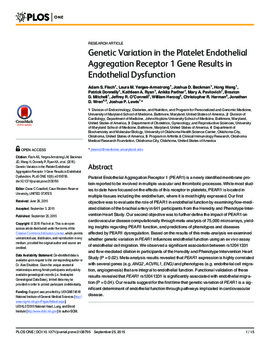| dc.contributor.author | Adam S. Fisch | |
| dc.contributor.author | Laura M. Yerges-Armstrong | |
| dc.contributor.author | Joshua D. Backman | |
| dc.contributor.author | Hong Wang | |
| dc.contributor.author | Patrick Donnelly | |
| dc.contributor.author | Kathleen A. Ryan | |
| dc.contributor.author | Ankita Parihar | |
| dc.contributor.author | Mary A. Pavlovich | |
| dc.contributor.author | Braxton D. Mitchell | |
| dc.contributor.author | Jeffrey R. O’Connell | |
| dc.contributor.author | William Herzog | |
| dc.contributor.author | Christopher R. Harman | |
| dc.contributor.author | Jonathan D. Wren | |
| dc.contributor.author | Joshua P. Lewis | |
| dc.date.accessioned | 2017-03-05T22:55:17Z | |
| dc.date.available | 2017-03-05T22:55:17Z | |
| dc.date.issued | 2015-09-25 | |
| dc.identifier.citation | Fisch AS, Yerges-Armstrong LM, Backman JD, Wang H, Donnelly P, Ryan KA, et al. (2015) Genetic Variation in the Platelet Endothelial Aggregation Receptor 1 Gene Results in Endothelial Dysfunction. PLoS ONE 10(9): e0138795. doi:10.1371/journal.pone.0138795 | en_US |
| dc.identifier.uri | https://hdl.handle.net/11244/49275 | |
| dc.description | We gratefully acknowledge our Amish liaisons and field workers and the extraordinary cooperation and support of the Amish community, without which these studies would not have been possible. We also acknowledge Dr. Alan Shuldiner for his impactful insights and guidance. | en_US |
| dc.description | | en_US |
| dc.description.abstract | Platelet Endothelial Aggregation Receptor 1 (PEAR1) is a newly identified membrane protein reported to be involved in multiple vascular and thrombotic processes. While most studies to date have focused on the effects of this receptor in platelets, PEAR1 is located in multiple tissues including the endothelium, where it is most highly expressed. Our first objective was to evaluate the role of PEAR1 in endothelial function by examining flow-mediated dilation of the brachial artery in 641 participants from the Heredity and Phenotype Intervention Heart Study. Our second objective was to further define the impact of PEAR1 on cardiovascular disease computationally through meta-analysis of 75,000 microarrays, yielding insights regarding PEAR1 function, and predictions of phenotypes and diseases affected by PEAR1 dysregulation. Based on the results of this meta-analysis we examined whether genetic variation in PEAR1 influences endothelial function using an ex vivo assay of endothelial cell migration. We observed a significant association between rs12041331 and flow-mediated dilation in participants of the Heredity and Phenotype Intervention Heart Study (P = 0.02). Meta-analysis results revealed that PEAR1 expression is highly correlated with several genes (e.g. ANG2, ACVRL1, ENG) and phenotypes (e.g. endothelial cell migration, angiogenesis) that are integral to endothelial function. Functional validation of these results revealed that PEAR1 rs12041331 is significantly associated with endothelial migration (P = 0.04). Our results suggest for the first time that genetic variation of PEAR1 is a significant determinant of endothelial function through pathways implicated in cardiovascular disease. | en_US |
| dc.language.iso | en_US | en_US |
| dc.publisher | PLos One | |
| dc.relation.ispartofseries | PLoS ONE 10(9): e0138795 | |
| dc.relation.uri | http://www.plosone.org/article/info%3Adoi%2F10.1371%2Fjournal.pone.0138795 | |
| dc.rights | Attribution 3.0 United States | |
| dc.rights.uri | https://creativecommons.org/licenses/by/3.0/us/ | |
| dc.subject | Endothelial cells,Cell migration,Platelet aggregation,Arteries,Microarrays,Alleles,Blood pressure,Meta-analysis | en_US |
| dc.title | Genetic Variation in the Platelet Endothelial Aggregation Receptor 1 Gene Results in Endothelial Dysfunction | en_US |
| dc.type | Research Article | en_US |
| dc.description.peerreview | Yes | en_US |
| dc.description.peerreviewnotes | http://www.plosone.org/static/editorial#peer | en_US |
| dc.identifier.doi | 10.1371/journal.pone.0138795 | en_US |
| dc.rights.requestable | false | en_US |

